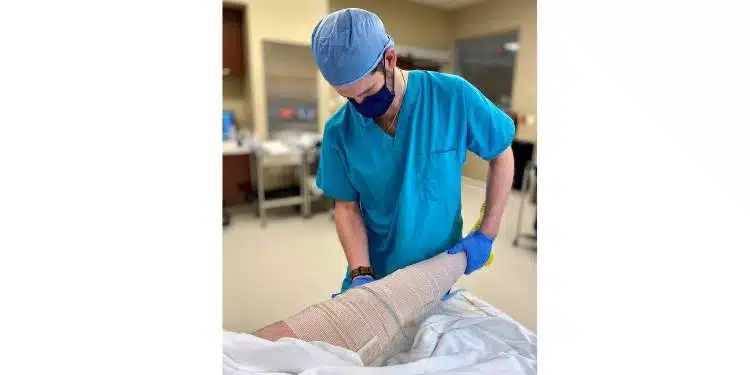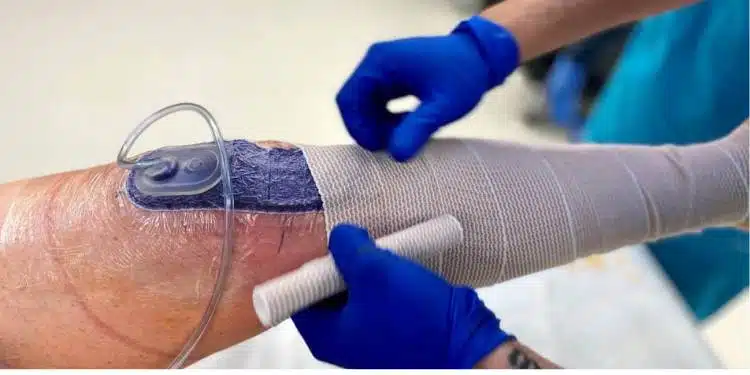by Dr. Adam Wright, Fellowship Trained Orthopedic Surgeon
Do you need a hip or knee replacement?
Has your doctor told you that you may need a hip replacement? Are you concerned that the nagging pain on the inside of your knee means you might need a knee replacement? For most people, the idea of getting around again without pain is exciting, but the prospect of surgery, a hospital stay, and an extended recovery is intimidating.
Here’s the good news. The field of joint replacement advanced rapidly over the past few years. Pain management is better, rehab is quicker, and many patients go home the same day as their surgery. Decades ago a hip or knee replacement was an ordeal. It was not unusual to spend up to a week before surgery in the hospital and sometimes months afterwards in a rehab facility. Scars were big, large amounts of narcotics prescribed, and the recovery time lengthy.

Joint replacement is not just for the elderly
Many people think the typical joint replacement patient is elderly and debilitated. While some patients are fragile, most of those I see lead active lives. They are tired of pain holding them back from their activities. Chasing grandchildren, golf, yoga, walking, hiking, skiing, and ice hockey are simply less enjoyable with hip or knee arthritis.
Life does not stop even when arthritis tries to slow it down
My patients need their new knees and hips to work quickly and for the long haul. Life does not stop even when arthritis tries to slow it down. One of my patients has an upcoming wedding where she wants to dance with her daughter without a limp. Another has a ski trip planned with his son for a celebratory graduation vacation.
The decision to have surgery is a big one, and the patient has to be ready. The patient understandably wants to know in advance that the recovery is predictable and takes a reasonable amount of time. Part of the advance planning involves minimizing the time spent in the hospital.
The shift to outpatient joint replacement surgery
The shift from joint replacement surgery taking place at major hospitals with long inpatient admissions to outpatient centers with short stays began several years ago. Several factors precipitated this change, but the trend intensified during the coronavirus pandemic. As with many healthcare changes, cost is a driving factor. Outpatient surgery is often less expensive for patients, hospitals, and insurance companies.
Joint replacement as an outpatient was also made possible by advancements in anesthetic care. Simply put, we are better at rehabbing patients from surgery now. Complications happen less often and better pain management is available. These improvements are due to a new strategy known as multimodal pain control. In addition, the emergence of minimally invasive techniques and advances such as patient-specific surgery guides and robotic assistance allow for less soft tissue trauma, smaller incisions, less pain and a faster recovery. Outpatient joint replacement surgery has many benefits, but I would like to focus on five different advantages that may matter most to you.

Advantages of outpatient joint replacement:
Decreased exposure to the healthcare system
We learned during the pandemic that less contact with people indoors is essential to decrease our risk. Outpatient joint replacements are generally performed at specialized centers. That usually means you won’t have an emergency room in the building or patients with pneumonia possibly next door to you. Fewer patients mean less people in the cafeteria, less nurses, less lab personnel, and overall a safer experience for you.
A more efficient and predictable surgery experience
If your surgeon offers you an outpatient surgery, she or he is likely a higher volume surgeon who performs a lot of joint replacements. Like any skill, surgical results are better with repetition. A doctor who treats joint replacement patients in an outpatient setting must be extremely familiar with every aspect of the procedure, and able to deliver consistent results with minimal, if any, complications. An outpatient joint surgeon is an efficient surgeon, which means they are likely more highly skilled. For this reason, a better outcome is more likely than with a physician who does a knee replacement once or twice a month. This means your postop plan for therapy may be more thought out, and your pain management regimen highly structured for your success. Every step is carefully planned to make your experience better.
Lower cost
While your insurance deductible may be the same no matter where you have surgery done, the overall expense is typically less in an outpatient setting. If you pay cash or if your insurance requires you cover a percentage of the final bill, the out of pocket cost is something to consider.
The comforts of home
No hospital food is usually considered a good thing. Also, you won’t need to wait for your nurse to bring your pain medicine because she is busy with other patients. You probably won’t need machines that beep in your home. No one will wake you at 2 am for vital sign checks. Perhaps best of all, there are no noisy neighbor patients.
Increased satisfaction level
A recent shift in medicine focuses on quality of care rather than quantity. With outpatient joint surgery, we found patients that went home the same day of surgery were usually happier. This is partially because doctors do much more work on the front end to prepare patients to go home early, and partially because patients who are interested take a more advocating role in their own care. There are fewer surprises, and less fear and uncertainty, which provides a better experience for all.
So, are you a candidate for outpatient joint replacement?
As great as it is, not everyone can or should be a candidate for outpatient joint replacement. Multiple studies show that in the properly selected patient, outpatient surgery is safe. However, it’s just not advisable for some patients. Specific conditions such as obstructive sleep apnea, urinary retention, prior narcotic use, chronic lung, cardiac or kidney conditions, or bleeding disorders may lead a doctor to consider at least a short inpatient stay to ensure no complications occur.
The bottom line
In my experience, a little less than half of my patients go home the day of surgery but nearly all are home within 24 hours. My patients are all ages, with varying levels of ability and different comorbidities. Whether your goal is to get back on the golf course, out on the slopes, or just around the mall, do not hesitate to reach out. With a strong support system and the motivation to work with your surgeon in the preparation phase, you may be very happy and better served by an outpatient joint replacement.
Talk with your surgeon to see if it may be the right choice for you.
Disclaimer: The information in this article is not intended as medical advice. Please consult your doctor if experiencing pain or illness.
About the author:
originally posted December 9, 2020
updated March 15, 2023



 Adam Wright, M.D. is a fellowship-trained orthopedic surgeon specializing in both routine and complex joint replacement of the hip and knee at the Plano Orthopedic & Sports Medicine Center in Plano, Texas. He is proficient in emerging and innovative techniques in primary and revision artheroplasty including minimally invasive surgery, anterior hip replacement, outpatient and rapid recovery total joint replacement, patient-specific or custom implants, robotic assisted surgery, computer navigation, infection, and fracture management. Learn more about
Adam Wright, M.D. is a fellowship-trained orthopedic surgeon specializing in both routine and complex joint replacement of the hip and knee at the Plano Orthopedic & Sports Medicine Center in Plano, Texas. He is proficient in emerging and innovative techniques in primary and revision artheroplasty including minimally invasive surgery, anterior hip replacement, outpatient and rapid recovery total joint replacement, patient-specific or custom implants, robotic assisted surgery, computer navigation, infection, and fracture management. Learn more about 






